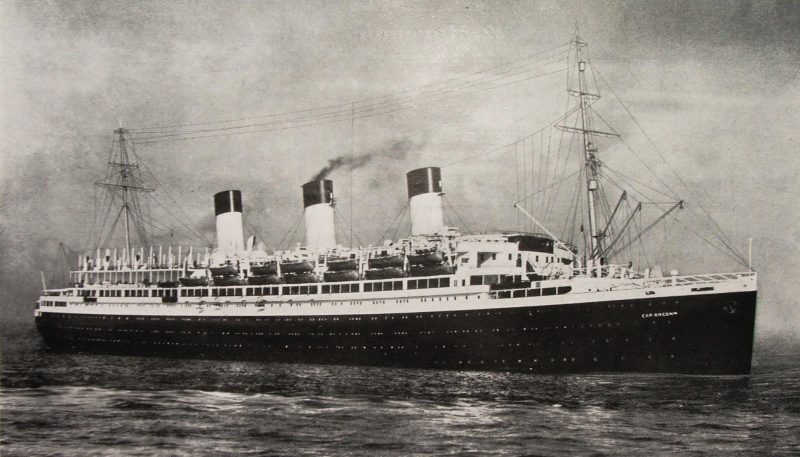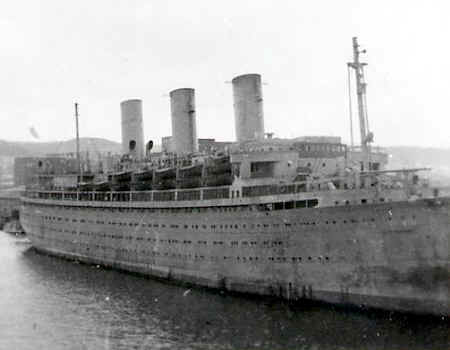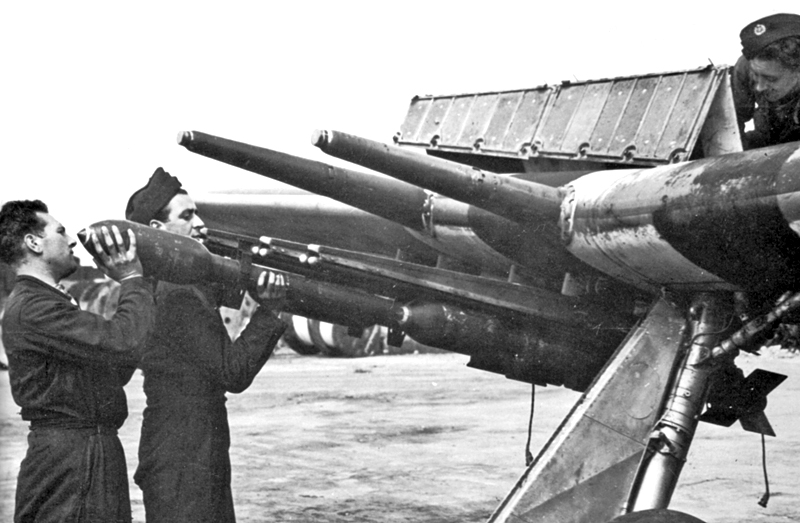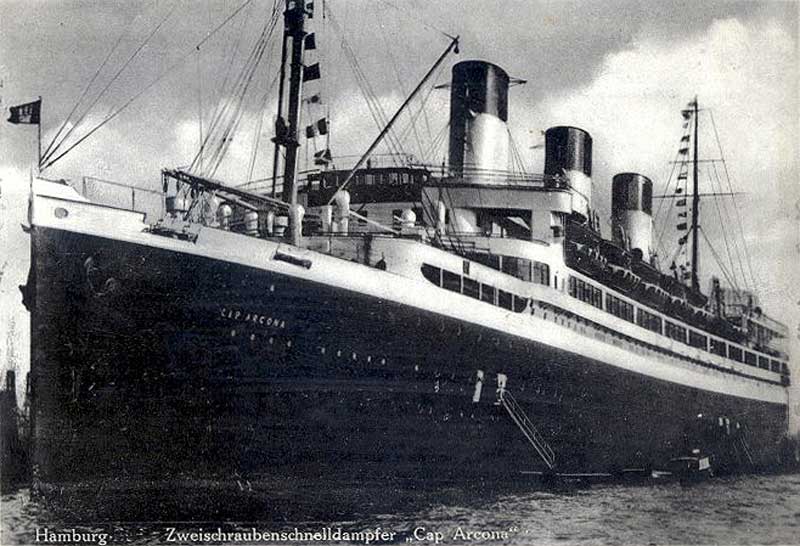
The tragic WWII story of how the RAF attacked and The Cap Arcona maritime tragedy, the loss of life in the Cap Arcona sinking is among the highest in maritime history. For weeks after the sinking, bodies of the victims were being washed ashore, where they were collected and buried in a single mass grave at Neustadt in Holstein. For nearly thirty years, parts of skeletons were being washed ashore, until the last find, by a twelve-year-old boy, in 1971.
There are several versions of what happened and why the RAF sunk the ship: (1) One version of the story is that the boarding of the prisoners with the knowledge that the ships would be attacked by Allied aircraft was a cynical trick by the German police authorities to have the prisoners killed. (2) Another version is that Count Folke Bernadotte, the Vice President of the International Red Cross had arranged for the transfer of prisoners to Swedish hospitals and that this was the purpose of the Cap Arcona’s last tragic voyage. Such transfers had previously taken place. (3) To this day, the responsibility of the German and British participants in the tragedy near Neustadt have not been judicially examined since the circumstances are not entirely clear. It is said that Red Cross radio operators attempted to warn the English against attacking the ships and to have notified them of the true situation on board. (4) The last word is that the RAF has sealed all records connected with the attack on the Cap Arcona until 2045.
Cap Arcona, named after Cape Arkona on the island of Rügen, was a large German ocean liner built for the Hamburg Südamerikanische Dampfschifffahrts-Gesellschaft (“Hamburg-South America Line”). She carried passengers and cargo between Germany and the east coast of South America, and in her time was the largest and quickest ship on the route.
In 1940 the Kriegsmarine requisitioned her as an accommodation ship. In 1942 she served as the set for the German propaganda feature film Titanic. In 1945 she evacuated almost 26,000 German soldiers and civilians from East Prussia before the advance of the Red Army. On 30 March 1945 Cap Arcona finished her third and last trip between Gdynia and Copenhagen, carrying 9,000 soldiers and refugees. However, her turbines were completely worn out. They could only be partially repaired and her days of long-distance travel were over. She was decommissioned, returned to her owners Hamburg-Süd and ordered out of Copenhagen Harbour to Neustadt Bay.
During March and April 1945, concentration camp prisoners from Scandinavian countries had been transported from all over the Reich to the Neuengamme concentration campnear Hamburg, in the White Bus programme co-ordinated through the Swedish Red Cross – with prisoners of other nationalities dispaced to make room for them. Eventually Himmler agreed that these Scandinavians, and selected others regarded as less harmful to Germany, could be transported through Denmark to freedom in Sweden. Then between the 16 and 28 April 1945, Neuengamme was systematically emptied of all its remaining prisoners, together other groups of concentration camp inmates and Soviet POWs; with the intention that they would be relocated to a secret new camp, either on the Baltic island of Fehmarn; or at Mysen in Norway where preparations were put in hand to house them under the control of concentration camp guards evacuated from Sachsenhausen.

In the interim, they were to be concealed from the advancing British and Canadian forces; and for this purpose the SS assembled a prison flotilla of decommissioned ships in the Bay of Lübeck, consisting of the liners Cap Arcona and Deutschland, the freighter Thielbek, and the motor launch Athen. Since the steering motors were out of use in Thielbek and the turbines were out of use in Cap Arcona, Athen was used to transfer prisoners from Lübeck to the larger ships and between ships; who were locked below decks and in the holds, and denied food and medical attention. On 30 April 1945 the two Swedish ships, Magdalena and Lillie Matthiessen, previously employed as support vessels for the White Bus evacuations, made a final rescue trip to Lübeck and back.
Amongst the prisoners rescued were some transferred from the prison flotilla. On the evening of 2 May 1945 more prisoners, mainly women and children from the Stutthof and Mittelbau-Dora camps were loaded onto barges and brought out to the anchored vessels; although, as the Cap Arcona refused to accept any more prisoners, over eight hundred were returned to the beach at Neustadt in the morning of 3 May, where around five hundred were killed in their barges by machine-gunning, or beaten to death on the beach, their SS guards then seeking to make their escape unencumbered.
The order to transfer the prisoners to the prison ships came from Gauleiter Karl Kaufmann in Hamburg. Marc Buggeln has challenged Kaufmann’s subsequent claim that he had been acting on orders from SS Headquarters in Berlin; arguing that the decision in fact resulted from political and business pressures from leading industrialists in Hamburg, who were already at this stage plotting with Kaufmann to hand the city over to British forces undefended and unharmed, and who consequently wished to whitewash away (literally so in the case of the Neuengamme concentration camp) all evidence for the prisoners’ former presence within the city and its industries.
By early May however, any relocation plans had been scotched by the rapid British military advance to the Baltic; so the SS leadership, which had moved to Flensburg on 28 April, discussed scuttling the ships with the prisoners still aboard. Later, at a war crimes tribunal, Kaufmann claimed the prisoners were intended to be sent to Sweden; although as none of the ships carried Red Cross hospital markings and nor were they seaworthy, this was scarcely credible. Georg-Henning Graf von Bassewitz-Behr, Hamburg’s last Higher SS and Police Leader (HSSPF), testified at the same trial that the prisoners were in fact to be killed “in compliance with Himmler’s orders”. Kurt Rickert, who had worked for Bassewitz-Behr, testified at the Hamburg War Crimes Trial that he believed the ships were to be sunk by U-boats or Luftwaffe aircraft. Eva Neurath, who was present in Neustadt, and whose husband survived the disaster, said she was told by a police officer that the ships held convicts and were going to be blown up.

On 2 May 1945, the British Second Army discovered the empty camp at Neuengamme, and reached the towns of Lübeck and Wismar. No. 6 Commando, 1st Special Service Brigade commanded by Brigadier Derek Mills-Roberts, and 11th Armoured Division, commanded by Major-General George P. B. Roberts, entered Lübeck without resistance. Lübeck contained a permanent Red Cross office in its function as a Red Cross port, and Mr. De Blonay of the International Committee of the Red Cross informed Major-General Roberts that 7,000–8,000 prisoners were aboard ships in the Bay of Lübeck. In the afternoon of 3 May 1945, the British 5th reconnaissance regiment advanced northwards to Neustadt, witnessing the ships burning in the bay and rescuing some severely emaciated prisoners on the beach at Neustadt, but otherwise finding mostly the bodies of women and children massacred that morning.
On 3 May 1945, three days after Hitler’s suicide and only one day before the unconditional surrender of the German troops in northwestern Germany at Lüneburg Heath to Field Marshal Montgomery, Cap Arcona, Thielbek, and the passenger liner Deutschlandwere attacked as part of general strikes on shipping in the Baltic Sea by RAF Typhoons of 83 Group of the 2nd Tactical Air Force. Through Ultra Intelligence, the Western Allies had become aware that most of the SS leadership and former concentration camp commandants had gathered with Heinrich Himmler in Flensburg, hoping to contrive an escape to Norway. The western allies had intercepted orders from the rump Dönitz government, also at Flensburg, that the SS leadership were to be facilitated in escaping Allied capture—or otherwise issued with false naval uniforms to conceal their identities—as Dönitz sought, while surrendering, to maintain the fiction that his administration had been free from involvement in the camps, or in Hitler’s policies of genocide.
The aircraft were from No. 184 Squadron, No. 193 Squadron, No. 263 Squadron, No. 197 Squadron RAF, and No. 198 Squadron. Besides four 20 mm cannon, these Hawker Typhoon Mark 1B fighter-bombers carried either eight HE High Explosive “60 lb” RP-3 unguided rockets or two 500 lb (230 kg) bombs.
None of the ships were Red Cross marked (although the Deutschland had previously been intended as a hospital ship, and retained one white painted funnel with a red cross), and all prisoners were concealed below deck, so the pilots in the attacking force were unaware that they were laden with concentration camp survivors. Swedish and Swiss Red Cross officials had informed British intelligence on 2 May 1945 of the presence of prisoners on ships at anchor in Lübeck Bay, but the information had failed to be passed on. The RAF commanders ordering the strike believed that a flotilla of ships was being prepared in Lübeck Bay, to accommodate leading SS personnel fleeing to German-controlled Norway in accordance with Dönitz’s orders.”The ships are gathering in the area of Lübeck and Kiel. At SHAEF it is believed that important Nazis who have escaped from Berlin to Flensburg are onboard, and are fleeing to Norway or neutral countries”.
Equipped with lifejackets from locked storage compartments, most of the SS guards managed to jump overboard from Cap Arcona. German trawlers sent to rescue Cap Arcona ‘ s crew members and guards managed to save 16 sailors, 400 SS men, and 20 SS women. Only 350 of the 5,000 former concentration camp inmates aboard Cap Arcona survived. From 2,800 prisoners on board the Thielbekonly 50 were saved; whereas all 2,000 prisoners on the Deutschland were safely taken off onto the Athen, before the Deutschland capsized.
RAF Pilot Allan Wyse of No. 193 Squadron recalled, “We used our cannon fire at the chaps in the water… we shot them up with 20 mm cannons in the water. Horrible thing, but we were told to do it and we did it. That’s war.”
Severely damaged and set on fire, Cap Arcona eventually capsized. Photos of the burning ships, listed as Deutschland, Thielbek, and Cap Arcona, and of the emaciated survivors swimming in the very cold Baltic Sea, around 7 °C (44.6 °F), were taken on a reconnaissance mission over the Bay of Lübeck by F-6 Mustang (the photo-reconnaissance version of the P-51) of the USAAF’s 161st Tactical Reconnaissance Squadron around 5:00 pm, shortly after the attack.
On 4 May 1945, a British reconnaissance plane took photos of the two wrecks, Thielbek and Cap Arcona, the Bay of Neustadt being shallow. The capsized hulk of Cap Arcona later drifted ashore, and the beached wreck was finally broken up in 1949.
s a light rain began to fall on the afternoon of May 3, 1945, British soldiers of 6 Commando, 1st Special Services Brigade, searched the beaches of Neustadt, Germany, on the Baltic Sea for survivors. The bodies of men, women, and even small children lay by the hundreds on the sands. Offshore, under a gray, smoke filled sky, the soldiers could see the the still-smoldering hulk of the former luxury liner, the Cap Arcona, and scores of other damaged ships. A highly effective RAF bombing and rocket raid had destroyed the fleet and killed over 7,000 concentration camp inmates who had been imprisoned on the ships.
One soldier found a girl of about seven clutching the hand of a woman beside her. He presumed she was the girl’s mother. Both bodies were clad in black-and-white-striped wool garments of concentration camp prisoners. The heads and shoulders of floating corpses were visible just offshore, as victims of all ages drifted in. Even a full year later, the bodies were still washing up.
It’s a story no one would tell. The British government ordered the records to be sealed for 100 years. The sinking of one of the most glamorouse ocean liners of the early twentieth century just had it’s 62nd anniversary, appears in no history books. The governments of Germany and Great Britain continue to to refuse either to discuss it or release pertinent records. So another war atrocity remains mostly a secret, like several other sinkings during the time period. 7000 dead is an awfully lot to not even be able to mention it
